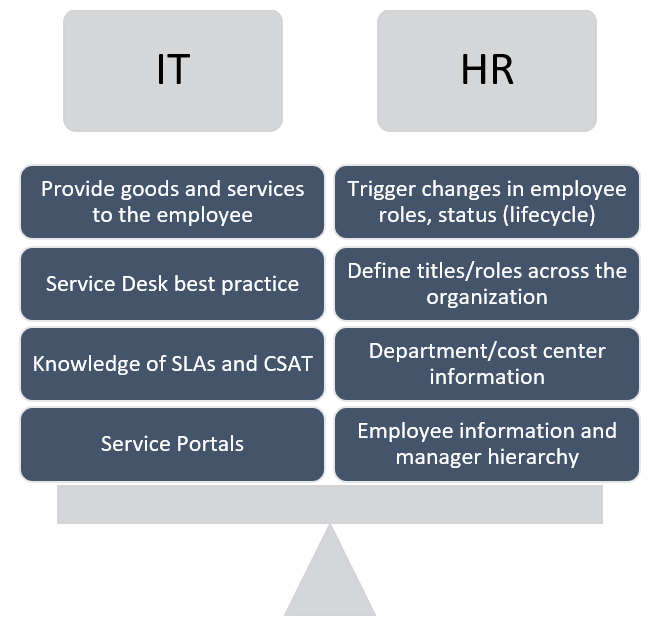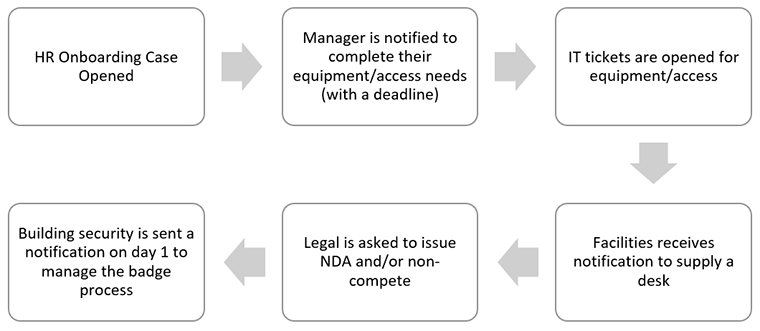Date Published March 20, 2019 - Last Updated December 17, 2019
It’s been said that “HR is the new IT.” This generally refers to a common direction towards building HR solutions centers and shared service center designs for managing employee needs. HR is also turning to case management tools to assist in daily operations and tracking inquiries. Take this a step further, and HR begins to look even more like IT, using a service portal and interfacing with IT for jointly fulfilled services like employee onboarding. In fact, many organizations begin their enterprise service management journey and start to bring other providers into their portal. When an organization begins operating in this manner, does IT need HR or does HR need IT? This blog will look at and answer this question.
Phyllis explores the benefits of ESM in depth at HDI Conference & Expo.
Join us!
Working in Silos
HR and IT have been enjoying their independent silos over the years. HR has as much information about employees as they need to manage them throughout their employment lifecycle. IT needs this data. At the same time, IT has tools and established service portals, as well as processes that touch many aspects of this lifecycle. HR can help provide information IT needs and when there is a relationship between the two organizations, ensure that employee changes are properly managed. It’s worth looking at the issues that arise when they do not work together.
HR has the data! IT relies on data for automating its processes and responses. Consider service requests for equipment. IT needs to know the requestor’s manager and sometimes director as well as the employee’s cost center. This is often referred to as foundation data. Without good foundation data from HR, this process and many others cannot be successfully automated. IT must rely on the requester to supply their manager’s name and cost center without any audit controls over this activity. In organizations where HR is not responsive to IT needs (holding their data tightly), there’s no workaround.

IT has the expertise! HR is not used to working in ticketing systems, typically doesn’t prioritize work according to SLAs (especially when it’s coming in and being written down on sticky notes) and has little experience in working as a support center. IT can help HR in a variety of different ways when HR sets up a solution center or shared service organization:
- Call center best practice advice and training (define processes for daily support)
- Assistance in establishing the flow of HR cases from the call center to the back-end centers of excellence (HR terminology for level 2 and level 3 support)
- Defining priorities and SLAs
- How to categorize and prioritize work
IT may also have a service management system that HR can leverage and a service portal they can use for employee engagement. Generally, these tools would also include access to a knowledge management product. Even if an HR application needs to be licensed and/or configured, IT can work with HR through the process, ensuring alignment in their customer-facing processes and tool configuration.
Now Entering: Enterprise Service Management
Enterprise service management (ESM) provides an opportunity for all service providers within an organization to use similar processes and, frequently, a single tool set. The end result is offering the employee a single-stop-shop for all of their daily needs, lowering uncertainty about how to gain the assistance they need, while increasing their engagement.
With enterprise service management, all service providers within an organization use similar processes and, frequently, a single tool set.

Consider the activities when an employee joins a company. HR kicks off the hiring process with an offer and initial background checks. The process takes enough time that IT and Facilities can be completely prepared for the new employee, but only if they’re engaged from the start of the process. In many organizations, the hiring manager needs to perform several activities to onboard the employee:
- Engage HR to trigger the onboarding process
- Contact IT for equipment and access
- Contact Facilities or Office Services to set up a place to sit, following up with IT for telecom needs once the desk is ready
- Work with building security for badges and building access
- Work with Legal if an NDA or non-compete agreement is needed
Now imagine the experience when enterprise service management is in play. Now, a single request from the portal can kick off all the tickets needed to ensure a smooth process.

Once the employee is on board, they can continue to engage any of the providers as needed through the service portal. Now when they make a request, their user record has manager information for approvals, cost center, contact information, and all of the data needed to process requests for goods and services from any provider, as HR is part of the process and the data from HR systems they need for HR case management can be made available to all providers (with personal information available only to HR).
Building an ESM Operating Model
While IT has service management frameworks that provide guidance on processes to support customer service activities, some of the other providers don’t. HR (and other providers) can benefit by IT’s experience, but not everything translates exactly as written for IT. Using some of these practices, along with the unique practices different providers bring along with them, the organization can create a set of standard procedures to use across all of the providers.
Governance is key to success with an ESM approach. When multiple providers are offering services through a single customer experience like a portal or global support center, the policies driving a consistent user experience become important. Only with a governing body to drive this consistency and agree to policies and procedures can this consistency be achieved. Policy areas to consider include:
-
Methods of engagement (channels). Provide a consistent portal experience, a single site to engage every provider. Also provide a single help line to contact, with voice menu direction to the appropriate specialists.
-
Supported languages. If one provider supports six languages, consumers will expect all to support them. Due to its nature and some compliance needs countries have around HR services, HR frequently supports more languages than other providers.
-
Service levels to expect from the provider. Policies should govern whether there will be a consistent set of service levels or whether each provider may establish their own, as well as establishing procedures around SLA communication.
-
Analyst and support adherence to operating standards. Tool use, procedures, communication etc.
-
Communication styles. Notifications that use the same language, for example.
-
Access to knowledge and information.
Ultimately, each provider needs to work with the overarching team to design an operating model that ensures both quality and consistency. HR can help in many of these areas through their people orientation, while IT has the greater understanding of service desk procedures like establishing and managing service level agreements.
ESM Provides Business Value
The value of enterprise service management is that it enables organizations to utilize this single operating model for all providers that offer goods and services internally, so associates know what they can expect. This goes a very long way towards improving productivity, streamlining and optimizing processes, and increasing employee satisfaction both for the providers and the consumers.
Additionally, as enterprises adopt this operating model, centralizing initial support becomes much easier and can lead to creation of a global solution center serving all employees and associates on behalf of all of the organization’s providers. Since some areas are highly specialized, skill-based routing assists by landing calls and work with the appropriate specialties. Combined with shift-left practices adopted by all providers in this model, personnel can be put to far more strategic work or operating costs can be lowered.
Phyllis Drucker is an ITIL® certified consultant and information leader at Linium, a Ness Digital Engineering Company. Phyllis has more than 20 years of experience in the disciplines and frameworks of IT service management, as both a practitioner and consultant. She has served HDI since 1997 and itSMF USA since 2004 in a variety of capacities including speaker, writer, local group leader, board member, and operations director. Since 1997, Phyllis has helped to advance the profession of ITSM leaders and practitioners worldwide by providing her experience and insight on a wide variety of ITSM topics through presentations, whitepapers, and articles and now her new book on the service request catalog, Online Service Management: Creating a Successful Service Request Catalogue (International Best Practice). Follow Phyllis on Twitter @msitsm.